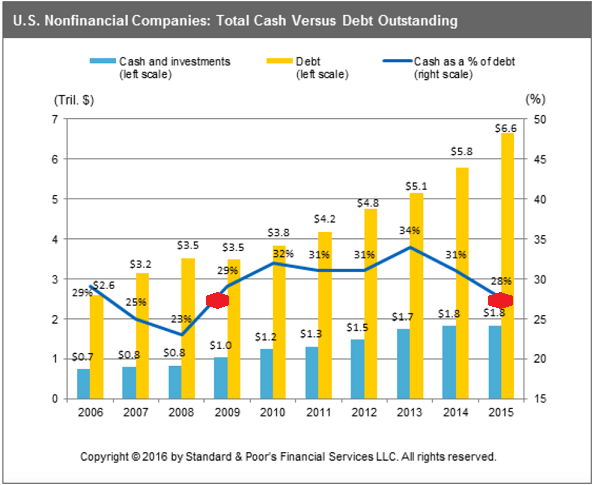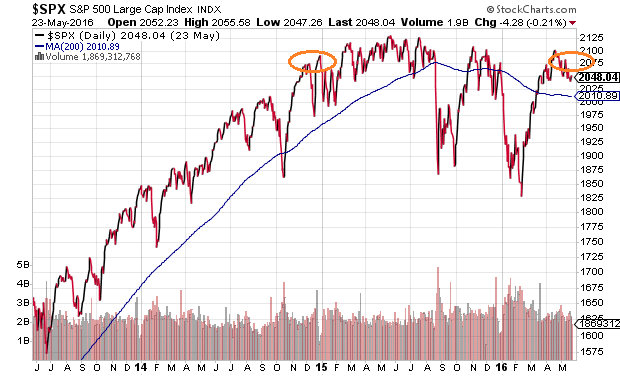Cash on corporate balance sheets grew at a 1% pace to $1.84 billion in 2015. That’s a record level of dollars on the books. On the other hand, debt grew at a clip of nearly 14.8% to $6.6 trillion from $5.75 trillion. That’s a 15% surge in debt obligations.
In fact, American companies have grown their debt load at a double-digit annualized rate since the economic recovery began in 2009. Doing so has put corporations in a precarious situation – circumstances where cash as a percentage of debt is lower than at any time since the Great Recession.

Obviously, the data points themselves are unnerving. Yet, the trend for cash as a percentage of total debt over time may be even more alarming. Consider what transpired between 2006 and 2008. Cash growth began to slow. Debt began to skyrocket. And cash as a percentage of debt steadily declined until, eventually, stocks of corporations found themselves losing HALF of their value.
Are stocks set to log -50% bearish losses going forward? Perhaps. Perhaps not. Yet the notion that debt can perpetually grow at a double-digit rate without adverse consequences is about as inane as the idea that the U.S. government’s debt troubles are irrelevant to the country’s well-being.

At least in the U.S. government’s case, its leadership can print currency and/or manipulate borrowing costs. (Note: That is not an endorsement of policy; rather, it is an acknowledgement of government power.) Companies? They’re at the mercy of the corporate bond market such that, when existing obligations are retired, new debt may need to be issued at much higher yields to entice investors.
Think about it. Ratings companies like S&P may find themselves downgrading scores of corporate bonds to junk status due to ungodly cash-to-debt ratios. What’s more, yield-seeking investors might squeamishly back away from speculation if spreads between corporates and treasuries widen further. Additionally, Fed efforts to raise overnight lending rates may push junk yields further out on the ledge where the combination of widening spreads, rating agency downgrades and Fed policy direction collectively reinforce a negative feedback loop.
By many accounts, low-rated bonds have been struggling for quite some time. Get a gander at the three-year chart of SPDR High Yield Corporate Bond (NYSE:JNK) below.

Granted, the bounce off of the February lows is astonishing. (Channel your gratitude toward a 70%-plus recovery in crude oil prices.) Nevertheless, the total return for JNK is a scant 1.4% over the three-year period. That is negligible reward for a huge amount of risk. In contrast, iShares 7-10 Year Treasury Bond (NYSE:IEF) offered a total return of 9.2% over the same period. That is low risk for reasonable reward.
The problem may only get worse. At present, junk status (‘BB’) is the average rating for companies issuing bonds. How bad is that historically? It’s worse than before, during or after the financial collapse in 2008-2009. Indeed, you have to travel back to the 2001 recession to find an average rating as anemic as the one that exists right now.
It is certainly true that when the European Central Bank (ECB) announced its quantitative easing (“QE”) intentions in the first quarter, the reality that they’d be acquiring corporate bonds as well as sovereign debt provided a fresh round of speculative yield seeking. Income producing assets that had been struggling under the worry of multiple Fed rate hikes in 2016 – emerging market sovereigns via PowerShares Emerging Market Sovereign Bond (NYSE:PCY), SPDR Barclays International Treasury (NYSE:BWX), high yield via iShares iBoxx High Yield Corporate (NYSE:HYG), crossover corporates via iShares Baa-Ba Rated (NYSE:QLTB) as well as iShares Intermediate Corporate Credit (NYSE:CIU) — rocketed higher.
On the flip side, the belief that yield-seeking and risk-seeking behavior will occur as long as central banks keep borrowing costs subdued is flawed. In the bond world, bad ratings eventually override yield-seeking speculation. In the stock world, stretched valuations eventually cap upside potential. It is worth noting, in fact, that the S&P 500 has been flat for 18 long months, which roughly corresponds to when corporate earnings peaked back on 9/30/2014.

Disclosure: Gary Gordon, MS, CFP is the president of Pacific Park Financial, Inc., a Registered Investment Adviser with the SEC. Gary Gordon, Pacific Park Financial, Inc, and/or its clients may hold positions in the ETFs, mutual funds, and/or any investment asset mentioned above. The commentary does not constitute individualized investment advice. The opinions offered herein are not personalized recommendations to buy, sell or hold securities. At times, issuers of exchange-traded products compensate Pacific Park Financial, Inc. or its subsidiaries for advertising at the ETF Expert web site. ETF Expert content is created independently of any advertising relationships.
